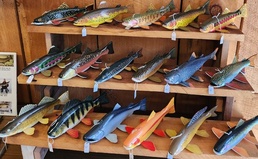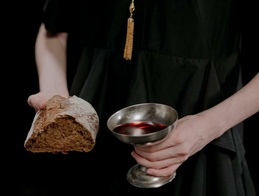
Get Your Hands Dirty!
Why backyard composting is easier, more impactful, and less stinky than you think
By Abby McKiernan | May 10, 2025
Let’s be honest—composting has a bit of a PR problem. Between the fears of weird smells, raccoon invasions, and the myth that you need expensive gear, composting has earned a reputation as something only hardcore environmentalists or people with acres of land take on.
But here’s the dirt: composting is actually simple, surprisingly forgiving, and can make a huge difference for the planet—right from your own backyard.
“It’s like cooking, not baking,” says Megan Alexander, composting expert and head of Carter’s Compost in Traverse City. “It doesn’t have to be an exact science. There’s room to play, experiment, and get your hands dirty.”
Carter’s Compost is known locally for its bike-powered food scrap pickups, offering a community-scale composting solution while also educating residents on how composting works and why it matters. Alexander’s biggest message? You don’t need a fancy bin, a subscription service, or a green thumb to get started.
The Science of Rotting Right
At its core, composting is controlled decomposition. Organic materials break down into a nutrient-rich soil amendment that feeds your garden and helps the environment. The process relies on four key ingredients: carbon (dry leaves, twigs, cardboard), nitrogen (food scraps, grass clippings), water, and air.
“When you get the balance right, you’re making soil that’s alive,” Alexander says. “It’s not just dirt—it’s full of beneficial microbes and nutrients. It’s like giving vitamins to your garden.”
Composting is nature’s original recycling system. Microorganisms “eat” your kitchen and yard waste, transforming it into what gardeners lovingly call “black gold.” And contrary to popular belief, it shouldn’t smell bad or attract pests—unless something’s off in your pile. Most often, that comes down to one simple concept: oxygen.
Aerobic vs. Anaerobic: Why It Matters
When it comes to composting, oxygen is everything. The success—and the smell—of your compost pile hinges on whether it’s aerobic or anaerobic.
Aerobic Composting (Good):
This means there’s enough oxygen in the pile for good bacteria to thrive. These helpful microbes break down your scraps efficiently and produce an earthy-smelling, crumbly compost. Why it’s good:
- Speeds up decomposition
- Produces only carbon dioxide and water vapor
- Doesn’t smell bad
- Supports healthy soil life
Anaerobic Composting (Bad):
When your pile is too wet, compacted, or sealed off from airflow, it becomes anaerobic—deprived of oxygen. That’s when the wrong bacteria move in, slowing the process and producing methane (a powerful greenhouse gas) along with some nasty smells. Why it’s bad:
- Slows down decomposition
- Produces methane
- Smells like rotten eggs or garbage
- Can lead to slimy, unusable compost
“If it smells bad, something’s off—but it’s an easy fix,” Alexander explains. “Do a squeeze test. Grab a handful—if it drips like a wet washcloth, it’s too wet. Just turn it to add air, or mix in some dry browns like shredded leaves or newspaper. That’s it—problem solved.”
The Power of Composting
The environmental impact of composting is staggering. According to the EPA, food scraps and yard waste make up more than 30 percent of what we throw away—and most of that could be composted instead. When organic waste ends up in a landfill, it decomposes without oxygen, producing methane, a greenhouse gas more potent than carbon dioxide.
“Half of what’s in our trash bins is organic,” Alexander says. That means every backyard compost pile is a mini climate solution—and a simple, grassroots way to make a positive environmental impact.
Beyond reducing waste and emissions, composting also skips the energy-intensive process of transporting and processing garbage. The end result? A rich, living soil amendment that improves soil structure, retains moisture, reduces the need for chemical fertilizers, and boosts underground biodiversity.
Clearing the Air: Common Composting Myths
Myth: Composting smells bad. Truth: If it’s balanced, your pile should smell earthy, not rotten. Bad odors usually mean it’s too wet or has too much nitrogen—both easy fixes.
Myth: You need a fancy tumbler or bin. Truth: “All you need is a shovel and a spot,” Alexander says. “That’s it. A pile on the ground works just fine.”
Myth: It attracts animals. Truth: It can—but mostly if you’re composting the wrong things. Skip meat, cheese, and dairy. Avoid “compostable” takeout containers too; they often need higher heat to break down and aren’t great for backyard systems.
Myth: It’s too complicated. Truth: Composting is more forgiving than you think. Every issue can be solved by adjusting one of the four basics: carbon, nitrogen, water, or air. “Keep it simple,” Alexander encourages. “Don’t let perfection get in the way of starting.”
Starting Your Pile
Whether you have a spacious backyard or just a sunny corner of a garden, you can compost. Here’s how:
First, pick your spot. Look for a dry, shaded area. You can compost in a pile, bin, or tumbler—whatever works for you. Then layer your ingredients like a lasagna: alternate “greens” (food scraps) with “browns” (dry leaves, cardboard). As you get going, water lightly. Aim for the consistency of a wrung-out sponge. You’ll need to turn your pile occasionally, aerating with a shovel or pitchfork to keep things moving.
And last, avoid problem items. No meat, bones, dairy, or the aforementioned compostable plastics unless you’ve got a hot pile and a critter-proof bin. And remember—if you mess it up? Adjust and try again. This is a process, not a pass/fail test.
Alexander says getting started composting is the hardest part. If you're not ready to manage your own pile, consider joining a local composting collective or drop-off program. (Traverse City locals, Carter’s Compost might be your answer.)
Local Author Gets Kids (and Grownups) Excited About Composting
When Traverse City author and illustrator Brianne Farley started talking to everyone she knew about composting, the questions began rolling in—mainly: “Are you writing a book about worms?”
“People kept asking me if I was working on a book about worms because I kept talking about it,” she says. “Until one day I thought, maybe I should write a book on composting.”
That spark turned into Worm Makes a Sandwich, a clever and colorful picture book starring a very determined worm who wants to make you lunch—with a little help from banana peels, carrot tops, and his decomposer friends. It’s equal parts science, silliness, and soil education.
Farley’s own composting journey began when she moved back to Traverse City from Brooklyn and wanted to start a garden in her new backyard. “I didn’t have enough space for a compost pile so I got a tumbler—and then it froze in the winter,” she says.
That kicked off a deep dive into winter composting, which led to vermicomposting. “I ordered 1,000 worms from Uncle Jim’s Worm Farm. For reference, 1,000 worms fit into a ball the size of a medium-sized orange—1 pound of worms is a totally normal thing to order online… normal people do that, right?”
She says composting is “easy, fun, and very low stakes,” and especially exciting for kids. “There is an incredible amount of life happening in your compost pile, and it’s so fun for kids to watch the bugs that move in and have a firsthand view of how dirt works and where food comes from.”
But it’s not just about what ends up in your garden. “The most important part of composting isn’t the end product,” she says. “It is about keeping biodegradable waste out of landfills.”
With Worm Makes a Sandwich, Farley blends her love of storytelling with her love of dirt, showing young readers (and their grownups) that composting doesn’t have to be complicated—or boring. Just don’t be surprised if your kid starts rooting around in the vegetable scraps after reading.
Trending

The Art of the Decoy
On mantles and shelves around the country (and indeed, around the world) sit intricate and beautiful wooden fish decoys that… Read More >>
Wreath the Halls
Get ready for the holidays with the ultimate wreath workshop! Boyne Mountain hosts Wreathfest, Saturday, Nov. 8, with Kalin … Read More >>
Saving Wild Elk Country
This fall, the elk population got a helping hand from their human friends. Gaylord-based conservation nonprofit Huron Pines … Read More >>


